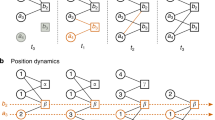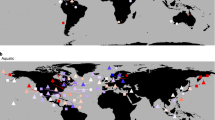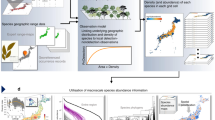Abstract
Population biologists have long been interested in the variability of natural populations1,2,3,4,5,6. One approach to dealing with ecological complexity is to reduce the system to one or a few species, for which meaningful equations can be solved. Here we explore an alternative approach7,8 by studying the statistical properties of a data set containing over 600 species, namely the North American breeding bird survey9. The survey has recorded annual species abundances over a 31-year period along more than 3,000 observation routes10. We now analyse the dynamics of population variability using this data set, and find scaling features in common with inanimate systems composed of strongly interacting subunits11. Specifically, we find that the distribution of changes in population abundance over a one-year interval is remarkably symmetrical, with long tails extending over six orders of magnitude. The variance of the population over a time series increases as a power-law with increasing time lag, indicating long-range correlation in population size fluctuations12. We also find that the distribution of species lifetimes (the time between colonization and local extinction) within local patches is a power-law with an exponential cutoff imposed by the finite length of the time series. Our results provide a quantitative basis for modelling the dynamics of large species assemblages.
This is a preview of subscription content, access via your institution
Access options
Subscribe to this journal
Receive 51 print issues and online access
$199.00 per year
only $3.90 per issue
Buy this article
- Purchase on Springer Link
- Instant access to full article PDF
Prices may be subject to local taxes which are calculated during checkout


Similar content being viewed by others
References
May, R. M. Biological populations with nonoverlapping generations: Stable points, stable cycles, and chaos. Science 186, 645–647 (1974).
Ives, A. R. Chaos in time and space. Nature 353, 214–215 (1991).
Turchin, P. Rarity of density dependence or population regulation with lags? Nature 344, 660–663 (1990).
Arino, A. & Pimm, S. L. On the nature of population extremes. Evol. Ecol. 9, 429–443 (1995).
Rhodes, C. J. & Anderson, R. M. Power laws governing epidemics in isolated populations. Nature 381, 600–602 (1996).
Curnutt, J. L., Pimm, S. L. & Maurer, B. A. Population variability of sparrows in space and time. OIKOS 76, 131–144 (1996).
Brown, J. H. Macroecology (Univ. of Chicago Press, Chicago, (1995)).
Keitt, T. H. & Marquet, P. A. The introduced Hawaiian avifauna reconsidered: Evidence for self-organized criticality? J. Theor. Biol. 182, 161–167 (1996).
Peterjohn, B. G. The North American breeding bird survey. J. Am. Birding Assoc. 26, 386–398 ((1994)).
Sauer, J. R., Hines, J. E., Gough, G., Thomas, I. & Peterjogn, B. G. The North American breeding bird survey results and analysis, version 96.3 (Patuxent Wildlife Research Center, Laurel, MD, (1997)). (http://www.mbr.nbs.gov/bbs/bbs.html)
Stanley, M. H. R. et al. Scaling behaviour in the growth of companies. Nature 379, 804–806 (1996).
Beran, J. Statistics for Long Memory Processes (Chapman and Hall, New York, (1994)).
Preston, F. W. The canonical distribution of commonness and rarity: I. Ecology 43, 185–215 (1962).
MacArthur, R. H. On the relative abundance of bird species. Proc. Natl Acad. Sci. USA 43, 293–295 (1957).
Sugihara, G. Minimal community structure: An explanation of species abundance. Am. Nat. 116, 770–787 (1980).
Hassell, M. P., Lawton, J. H. & May, R. M. Patterns of dynamical behavior in single-species populations. J. Anim. Ecol. 45, 471–486 (1976).
Royoma, T. Analytical Population Dynamics (Chapman and Hall, London, (1992)).
Connell, J. H. & Sousa, W. P. On the evidence needed to judge ecological stability or persistence. Am. Nat. 121, 789–824 (1983).
Pimm, S. L. & Redfearn, A. The variability of population densities. Nature 334, 613–614 (1988).
Steele, J. H. Acomparison of terrestrial and marine ecological systems. Nature 313, 355–358 (1985).
Pitts, T. D. Eastern bluebird populations fluctuations in Tennessee during 1970–1979. The Migrant 52, 29–37 (1981).
Sauer, J. R. & Droege, S. Recent population trends of the eastern bluebird. Wilson Bull. 102, 239–252 (1990).
Sauer, J. R., Pendleton, G. W. & Peterjohn, B. G. Evaluating causes of population change in North American insectivorous songbirds. Conservation Biol. 10, 465–478 (1996).
Hanski, I. & Gilpin, M. Metapopulation dynamics: Brief history and conceptual domain. Biol. J. Linn. Soc. 42, 3–16 (1991).
Hanski, I., Foley, P. & Hassell, M. Random walks in a metapopulation: How much density dependence is necessary for long-term persistence? J. Anim. Ecol. 65, 274–282 (1996).
Diamond, J. M. & May, R. M. Species turnover rates on islands: Dependence on census interval. Science 197, 266–270 (1977).
Schoener, T. W. & Spiller, D. A. High population persistence in a system with high turnover. Nature 330, 474–477 (1987).
Pimm, S. L., Diamond, J., Reed, T. M., Russell, G. J. & Verner, J. Times to extinction for small populations of large birds. Proc. Natl. Acad. Sci. USA 90, 10871–10875 (1993).
Stanley, H. E. Introduction to Phase Transitions and Critical Phenomena (Oxford Univ. Press, Oxford, (1971)).
Stanley, H. E. Power laws and universality. Nature 378, 554 (1995).
MacArthur, R. H. & Wilson, E. O. Island Biogeography (Princeton Univ. Press, (1967)).
Hanski, I. Apractical model of metapopulation dynamics. J. Anim. Ecol. 63, 151–162 (1994).
Brown, J. H. & Kodric-Brown, A. Turnover rates in insular biogeography: effect of immigration on extinction. Ecol. 58, 445–449 (1977).
Acknowledgements
This work was partially supported by the Santa Fe Institute, Thaw Foundation and National Science Foundation. We thank B. Peterjohn and the Patuxent Wildlife Research Center, United States Department of the Interior, for providing the NA BBS data in digital form, and L. A. N. Amaral, P.Bak, J. H. Brown, P. A. Marquet, B. Maurer, R. M. May, B. T. Milne, M. Paczuski, B. Peterjohn, S.L.Pimm, R. V. Solé and M. Taper for their comments.
Author information
Authors and Affiliations
Corresponding author
Rights and permissions
About this article
Cite this article
Keitt, T., Stanley, H. Dynamics of North American breeding bird populations. Nature 393, 257–260 (1998). https://doi.org/10.1038/30478
Received:
Accepted:
Issue Date:
DOI: https://doi.org/10.1038/30478
This article is cited by
-
Environmental Stochasticity Driving the Extinction of Top Predators in a Food Chain Chemostat Model
Journal of Nonlinear Science (2024)
-
Scale-dependent power law properties in hashtag usage time series of Weibo
Scientific Reports (2023)
-
The concerted emergence of well-known spatial and temporal ecological patterns in an evolutionary food web model in space
Scientific Reports (2021)
-
Exploring the dimensions of metapopulation persistence: a comparison of structural and temporal measures
Theoretical Ecology (2021)
-
Landscape Engineering Impacts the Long-Term Stability of Agricultural Populations
Human Ecology (2021)
Comments
By submitting a comment you agree to abide by our Terms and Community Guidelines. If you find something abusive or that does not comply with our terms or guidelines please flag it as inappropriate.



